Relational operators are operators that help us see how one R object relates to another.
4 Types of Relational Operators in R
- Equality operator: ==
- Inequality operator: !=
- Less than/greater than operator: < and >
- Less than or equal to/greater than or equal to operator: <= and >=
Equality Operator (==) in R
You can check whether two objects are equal (equality) by using a double equals sign ==.
We can see if the logical value of TRUE equals the logical value of TRUE by using this query TRUE == TRUE. The result of the equality query is a logical value ( TRUE or FALSE). In this case, it’s TRUE because TRUE equals TRUE.
On the contrary, TRUE == FALSE will give us FALSE.
Apart from logical variables, we can also check the equality of other types, such as strings and numbers.
# Comparing the equality of two strings
"hello" == "goodbye"
# Comparing the equality of two numbers
3 == 2Both of these output FALSE.
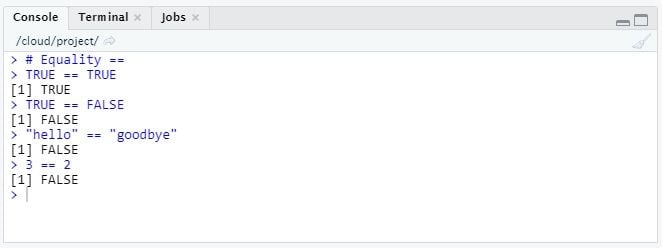
Equality Operator Examples
The most basic form of comparison is equality. Recall that it’s represented by the double equation sign syntax, ==. Here is an example of some equality statements:
3 == (2 + 1)
"ultimate guide" == "r"
TRUE == FALSE
"Rchitect" == "rchitect"
Notice that R is case sensitive: “R” is not equal to “r.”
Try the following comparisons:
- Write R code to see if
TRUEequalsFALSE. - Check to see if
-6 * 14is equal to17 — 101. - See if the strings
"useR"and"user"are equal in R. - Find out what happens if you compare
TRUEto the numeric 1.
Make sure not to mix up == (comparison) and = (assignment), as == is what’s used to check equality of R objects.
Solution
# Comparison of logicals
TRUE == FALSE
# Comparison of numerics
(-6 * 14) == (17 - 101)
# Comparison of character strings
"useR" == "user"
# Comparison of a logical with a numeric, where TRUE is coerced to 1 and FALSE to 0
TRUE == 1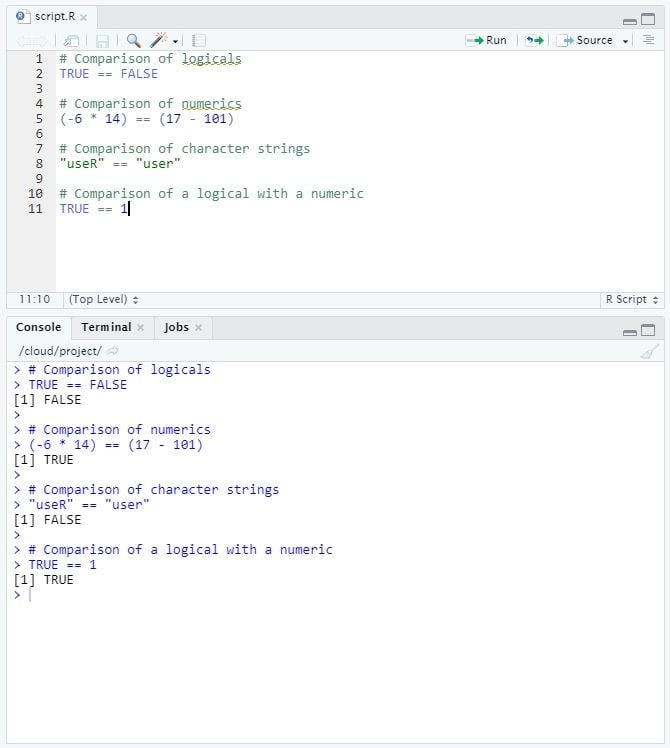
Inequality Operator (!=) in R
The opposite of the equality operator is the inequality operator, written as an exclamation mark followed by an equals sign ( != ).
For example, the sentence "hello" != "goodbye" would read as: “hello” is not equal to “goodbye.” Because this statement is correct, R will output TRUE.
The inequality operator can also be used for numerics, logicals and other R objects.
# Output FALSE
TRUE != TRUE
# Output TRUE
TRUE != FALSE
# Output TRUE
"hello" != "goodbye"
# Output TRUE
3 != 2The result of the equality operator is the opposite for the inequality operator. This holds true for most values, but comparisons involving NA may return NA, rather than TRUE or FALSE.
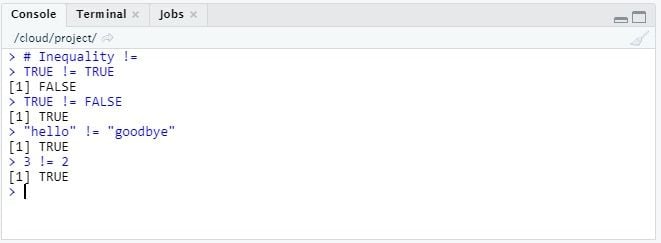
Inequality Operator Example
The inequality operator is the opposite of equality. The following statements all evaluate to TRUE :
3 == (2 + 1)
"intermediate" != "r"
TRUE != FALSE
"Rchitect" != "rchitect"Write out expressions that do the following:
- Check if
TRUEequalsFALSE. - Check if
— 6 * 14is not equal to17 — 101. - Check if the strings
“useR”and“user”are different. - Check if
TRUEand 1 are equal.
Solution
# Comparison of logicals
TRUE == FALSE
# Comparison of numerics
(-6 * 14) != (17-101)
# Comparison of character strings
"useR" != "user"
# Compare a logical with a numeric, where TRUE is coerced to 1 and FALSE to 0
TRUE == 1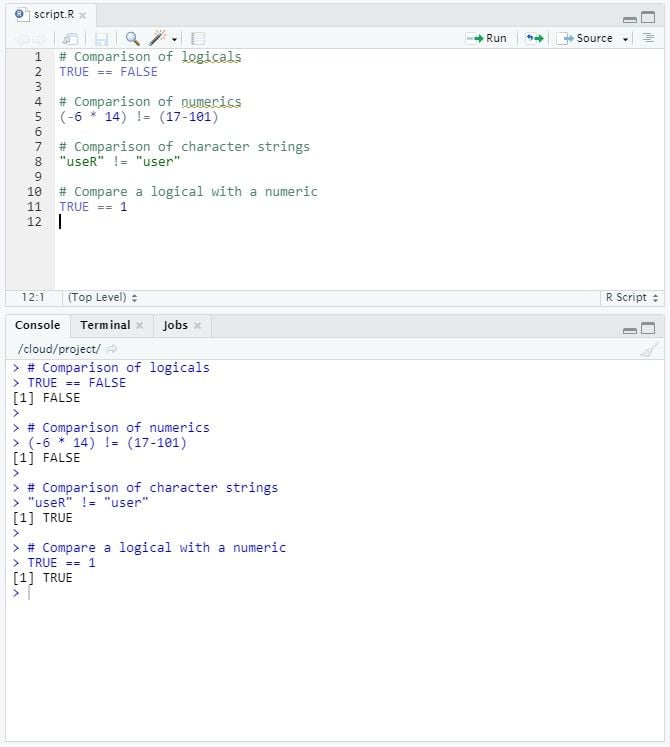
Less Than and Greater Than Operators (< and >) in R
There are also situations where we need more than equality and inequality operators. For instance, what about checking if an R object is “less than” or “greater than” another R object? In this case, we can use the less than < and greater than > sign for this.
In the case of numerical values, this is pretty straightforward. For example, three is less than five, so 3 < 5 will evaluate to TRUE, while three is not greater than five so 3 > 5 will evaluate to FALSE.
For numerics, this makes sense. But how would this work for character strings and logical values?
For character strings, R uses the alphabet to sort them. So, "Hello" > "Goodbye" would evaluate to TRUE since “H” comes after “G” in the alphabet, and R considers it greater.
For logical values, TRUE corresponds to 1, and FALSE corresponds to 0. So, is TRUE less than FALSE? No, because 1 is not less than 0, hence the FALSE result.
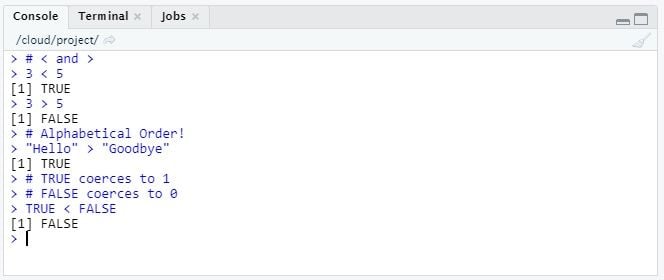
The Less Than or Equal To, and Greater Than or Equal To Operators (<= and >=) in R
We can also check to see if one R object is greater than or equal to (or less than or equal to) another R object. To do this, we can use the less than sign or the greater than sign together with the equals sign.
So, we can write five is greater than or equal to three 5 >= 3, as well as three is greater than or equal to three 3 >= 3, which will evaluate as TRUE.

Less Than and Greater Than or Equal To Operator Examples
Apart from equality operators ( == and != ), we also learned about the less than and greater than operators: < and >. We can also add an equal sign to express less than or equal to or greater than or equal to, respectively. For example, the following all evaluate to FALSE:
(1+2) > 4
"dog" < "Cats"
TRUE <= FALSERemember that for string comparison, R determines the greater than relationship based on alphabetical order. Also keep in mind that TRUE is treated as 1 for arithmetic, and FALSE is treated as 0. Therefore, FALSE < TRUE is TRUE .
Write R expressions to check whether:
-6 * 5 + 2is greater than or equal to-10 + 1.“raining”is less than or equal to“raining dogs”TRUEis greater thanFALSE.
Solution
# Comparison of numerics
(-6 * 5 + 2) >= (-10 + 1)
# Comparison of character strings
"raining" <= "raining dogs"
# Comparison of logicals
TRUE > FALSE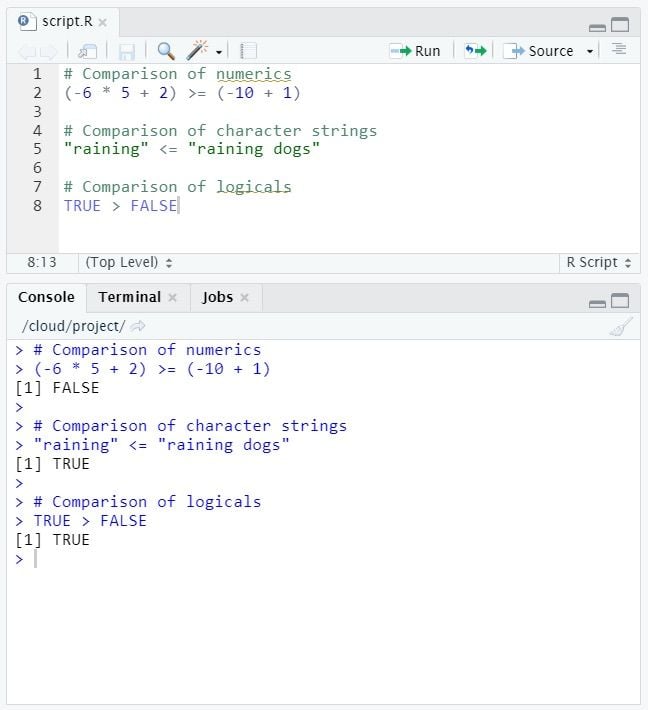
Relational Operators and Vectors in R
We already know that R is pretty good with vectors. Without having to change anything about the syntax, R’s relational operators also work on vectors.
Suppose you’ve recorded the daily number of views your LinkedIn profile had in the previous link, and you stored them in a vector, linkedin.
linkedin <- c(16, 9, 13, 5, 2, 17, 14)If we want to find out on which days the number of views exceeded 10, we can use the greater than sign.
linkedin > 10
The first, third, sixth and seventh element in the vector all have views greater than 10. So, for these elements the result will be TRUE.
We can also compare vectors to vectors. Suppose you also recorded the number of views your Facebook profile had the previous week and saved them in another vector facebook.
facebook <- c(17, 7, 5, 16, 8, 13, 14)When are the number of Facebook views less than or equal to the number of LinkedIn views? We can use the following expression to calculate this.
facebook <= linkedinIn this case, the comparison is done for every element of the vector, one at a time. For example, on the third day, the number of Facebook views is five, and the number of LinkedIn views is 13. The comparison evaluates to TRUE, as five is smaller than or equal to 13. This means that the number of Facebook views is less than or equal to the number of LinkedIn views on the third day.

Relational Operators in Vectors Example
Using the same social media vectors above, linkedin and facebook, which contain the number of profile views over the last seven days, use relational operators to find a logical answer ( TRUE or FALSE ) for the following questions:
- On which days did the number of LinkedIn profile views exceed 15?
- When was your LinkedIn profile viewed only five times or fewer?
- When was your LinkedIn profile visited more often than your Facebook profile?
# The linkedin and facebook vectors
linkedin <- c(16, 9, 13, 5, 2, 17, 14)
facebook <- c(17, 7, 5, 16, 8, 13, 14)Solution
# The linkedin and facebook vectors
linkedin <- c(16, 9, 13, 5, 2, 17, 14)
facebook <- c(17, 7, 5, 16, 8, 13, 14)
# Popular days
linkedin > 15
# Quiet days
linkedin <= 5
# LinkedIn more popular than Facebook
linkedin > facebook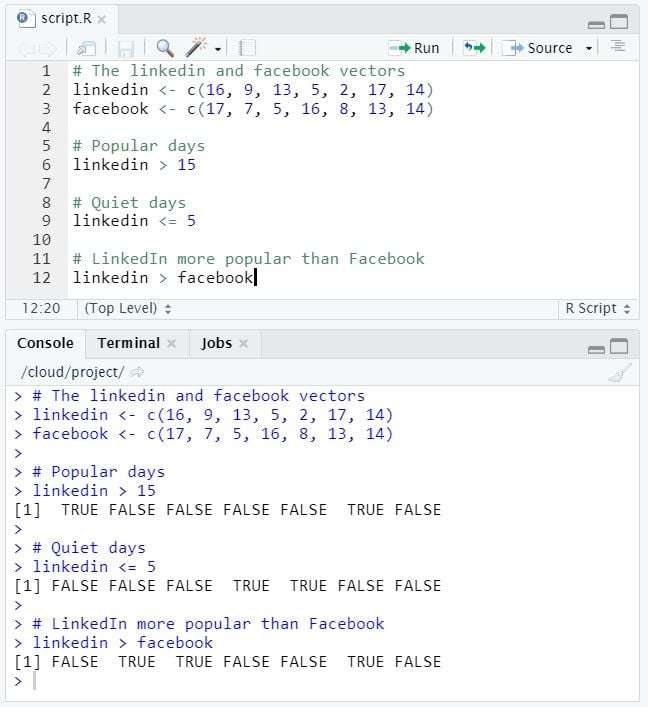
From the output, we can determine the following:
- Your LinkedIn profile views exceed 15 on the first and sixth day.
- Your LinkedIn profile was only viewed five or less times on the fourth and fifth day.
- Your LinkedIn profile was visited more than your Facebook profile on the second, third and sixth day.
Challenge: Compare Matrices in R
Up to now, we’ve learned and compared logicals, numerics, strings and vectors. However, R’s ability to deal with different data structures for comparisons does not stop at matrices. Matrices and relational operators also work together seamlessly.
Instead of using vectors, suppose the LinkedIn and Facebook data is stored in a matrix called views. The first row contains the LinkedIn information, and the second row the Facebook information.
# The social data stored in a matrix
linkedin <- c(16, 9, 13, 5, 2, 17, 14)
facebook <- c(17, 7, 5, 16, 8, 13, 14)
views <- matrix(c(linkedin, facebook), nrow = 2, byrow = TRUE)Using the relational operators you’ve learned, try to determine the following:
- When were the views exactly equal to 13? Use the
viewsmatrix to return a logical matrix. - For which days were the number of views less than or equal to 14? Again, have R return a logical matrix.
Solution
# The social data
linkedin <- c(16, 9, 13, 5, 2, 17, 14)
facebook <- c(17, 7, 5, 16, 8, 13, 14)
views <- matrix(c(linkedin, facebook), nrow = 2, byrow = TRUE)
# When does views equal 13?
views == 13
# When is views less than or equal to 14?
views <= 14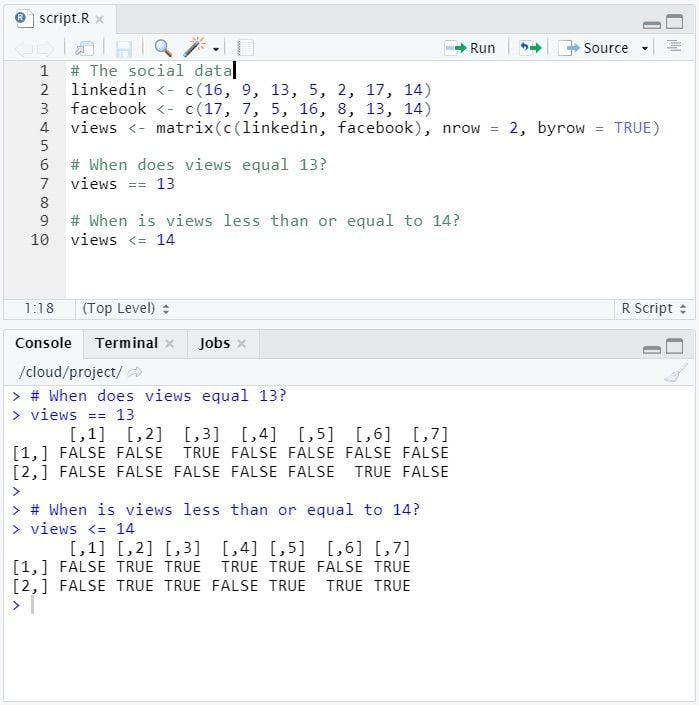
The output will be a logical matrix with the same dimensions, where each element indicates the result of the comparison for that cell.
From the output we can determine:
- On day three, there were 13 LinkedIn views. On day six, there were 13 Facebook views.
- On days two, three, four, five and seven, there were less than or equal to 14 LinkedIn views. On days two, three, five, six and seven there were less than or equal to 14 Facebook views.
Frequently Asked Questions
What are relational operators in R?
Relational operators in R are used to compare two objects and return a logical value (TRUE or FALSE) based on the comparison. The main types of relational operators in R include the equality operator (==), inequality operator (!=), less than/greater than operator (< and >) and less than or equal to/greater than or equal to operator (<= and >=).
What is the difference between == and = in R?
In R, == is used for comparison, while = is used for assignment or in function arguments.
Can relational operators compare strings in R?
Yes, relational operators in R can compare strings alphabetically. For example, "Hello" > "Goodbye" returns TRUE because "H" comes after "G" in the English alphabet.





